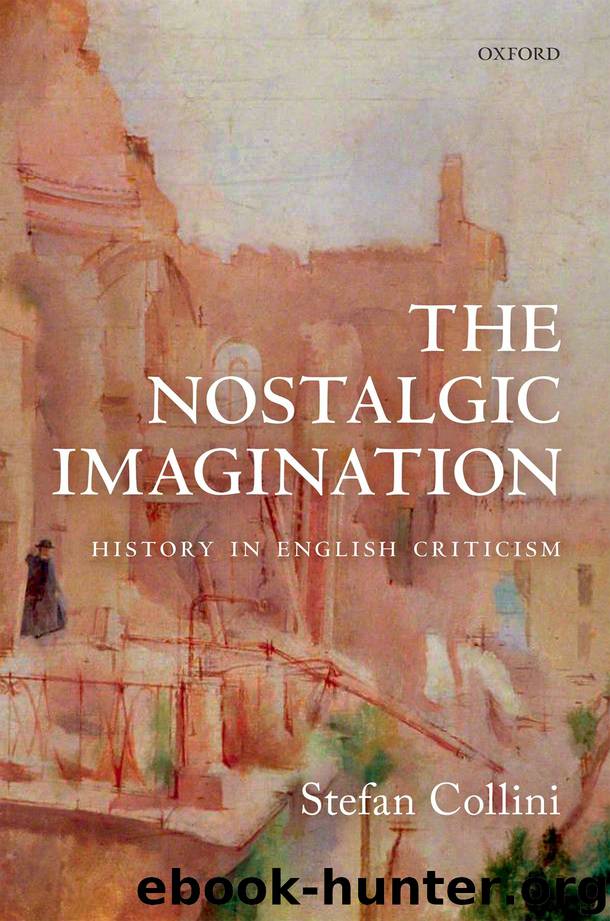The Nostalgic Imagination by Collini Stefan;

Author:Collini, Stefan; [Collini, Stefan]
Language: eng
Format: epub
Publisher: Oxford University Press USA - OSO
Published: 2018-09-25T00:00:00+00:00
5
The History of ‘the Reading Public’
I
The charged topic of ‘the reading public’ appears to be ineliminably historical. Generalizations about this reified entity almost always have assumptions about either ‘growth’ or ‘decline’ built into them, and so presuppose, if only implicitly, larger historical stories. More specifically, accounts of the history of the reading public can often turn out to be indirect ways of writing the history of cultural elites and their relations with other social groups. In the middle decades of the twentieth century, one of the most influential channels through which literary critics disseminated wider historical understandings was through their treatment of this ever-elusive entity. Here the most detailed historical discussion was provided by Q. D. Leavis’s 1932 book Fiction and the Reading Public (to avoid confusion, its author will be referred to as ‘QDL’ and her husband as ‘Leavis’).1 While there are complexities to the relationship between the Leavises, and contrasts between their characteristic styles of writing, these may be set aside for the present, since the consilience of their views on this topic is not in doubt. Leavis and the Scrutiny circle always treated QDL’s book as a founding document, one that provided the necessary historical and sociological evidence to underwrite their relentlessly bleak analysis of the contemporary cultural situation. The book has to be recognized as a major expression of the Leavises’ engagement with history.
Not that History figures as the most salient contiguous discipline in the Leavises’ early work. From the outset, Scrutiny described its approach as ‘anthropological’. When Leavis had first referred to Middletown as early as his 1930 pamphlet, only a year after the book’s publication, he had called it ‘a remarkable work of anthropology’.2 And, when QDL submitted her work for a Ph.D. in late 1931, it was subtitled ‘A Study in Social Anthropology’.3 Although she (wisely) dropped this for publication, the emphasis it signalled remained—namely, a commitment to exploring broad social patterns of taste that went beyond that small number of works a literary critic would have considered worth attention.4 However, this most certainly did not signal the ‘value-neutral’ approach of the social scientist, since the book is frankly and unapologetically evaluative throughout.
The ostensible focus of Fiction and the Reading Public is the present: it contains a good deal of information about the current marketing and reviewing of different kinds of publication, chiefly novels, as well as other features of contemporary literary journalism. But the presentation of this material is underwritten by what is, in its condensed form, a relatively simple developmental sequence. Once upon a time, there was only one public, and so the taste of the cultivated set the standards of taste as a whole. Since then, there has been a vast expansion of cheap (= low-quality) publications for much bigger markets, so now the taste of the cultivated is confined to a small minority of the population. This means that standards have fallen catastrophically; an interest in serious literature is confined to an embattled minority, largely without influence on the broader publics.
Download
This site does not store any files on its server. We only index and link to content provided by other sites. Please contact the content providers to delete copyright contents if any and email us, we'll remove relevant links or contents immediately.
| Ancient & Classical | Arthurian Romance |
| Beat Generation | Feminist |
| Gothic & Romantic | LGBT |
| Medieval | Modern |
| Modernism | Postmodernism |
| Renaissance | Shakespeare |
| Surrealism | Victorian |
4 3 2 1: A Novel by Paul Auster(11071)
The handmaid's tale by Margaret Atwood(6870)
Giovanni's Room by James Baldwin(5890)
Big Magic: Creative Living Beyond Fear by Elizabeth Gilbert(4730)
Asking the Right Questions: A Guide to Critical Thinking by M. Neil Browne & Stuart M. Keeley(4592)
On Writing A Memoir of the Craft by Stephen King(4221)
Ego Is the Enemy by Ryan Holiday(3999)
Ken Follett - World without end by Ken Follett(3980)
The Body: A Guide for Occupants by Bill Bryson(3813)
Bluets by Maggie Nelson(3721)
Adulting by Kelly Williams Brown(3678)
Guilty Pleasures by Laurell K Hamilton(3597)
Eat That Frog! by Brian Tracy(3522)
White Noise - A Novel by Don DeLillo(3439)
The Poetry of Pablo Neruda by Pablo Neruda(3370)
Alive: The Story of the Andes Survivors by Piers Paul Read(3318)
The Bookshop by Penelope Fitzgerald(3234)
The Book of Joy by Dalai Lama(3231)
Fingerprints of the Gods by Graham Hancock(3218)
